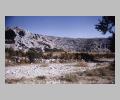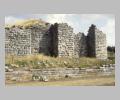
The Entrace to Dodona, Epirus, Dodona.
| Summary: | The major sanctuary of Zeus in northern Greece. |
| Type: | Sanctuary |
| Region: | Epirus |
Periods:
Geometric
Archaic
Classical
Hellenistic
Roman
Physical:
Located S of Lake Pambotis at the foot of Mt. Tomaros, ca. 20 km S of Ioannina, the sanctuary consisted originally of a sacred oak tree, possibly enclosed by a ring of bronze tripods. It developed into a temenos that included several temples, theater, stadium, and a number of stoas. Just above the sanctuary is a refuge acropolis enclosed by fortification walls dating to the 4th century B.C. In the temenos of the sanctuary is a bouleuterion where the delegates of the Epirote League held council.
Description:
The sanctuary of Zeus at Dodona, already known in the Homeric epics, was traditionally the home of the earliest oracle in Greece. Early to Late Bronze Age finds have been excavated at the site, but the earliest archaeological evidence for cult activity dates to the 8th century B.C. At this early date the sanctuary consisted of a sacred oak tree (or grove) possibly surrounded by a ring of bronze tripods. At the end of the 5th century B.C. or early in the 4th, the first stone temple was constructed and the sacred oak was enclosed in a stone peribolos wall.
During the 4th century, the bouleuterion and 3 temples (probably to Aphrodite, Dione, and Themis) were added, and a fortified refuge was constructed above the sanctuary. Beginning with the rule of King Pyrrhos (297-272 B.C.), who promoted the site as a pan-Hellenic sanctuary, Dodona developed a more monumental character. In the 3rd century B.C. the temenos was enlarged and the theater, Temple of Herakles, and stoas were added. In 232 B.C. Dodona became the center of the newly formed Epirote League. The sanctuary was destroyed by the Aetolians in 219 B.C., but was immediately rebuilt by the League and Philip V with spoils taken from the Aetolians. During the 3rd century a stadium with stone seats was also added to the sanctuary.
In 168 B.C. the site was destroyed by the Romans and only slightly repaired before it was again ravaged in 88 B.C. by Mithradates and the Thracians. Although the Naia Festivals and the activities of the oracle continued into the 3rd century A.D., the sanctuary never recovered from the destruction of 168 B.C. and was in a ruinous state already in the 1st century B.C. In the time of Augustus the theater had been converted into an arena and, as at the sanctuary of Artemis Orthia at Sparta, the religious function of the site seems to have been reduced in the Roman period to its tourist appeal. In the 5th or 6th century A.D. a Christian basilica was constructed on the site with reused ancient materials.
The Naia Festival (athletic and drama contests) was held every 4 years in honor of Zeus. The earliest attendants were males, the selloi, but were later replaced by priestesses. The oracular responses seemed to have been originally the oral report on sounds caused by the rustling of leaves, cooing of doves, or the ringing of metal tripods, but by the 6th century B.C. applications and occasionally the oracle's responses were written on lead tablets.
Exploration:
Located and 1st excavated by C. Carapanos in 1875. Excavations for the Greek Archaeological Service by D. Evangelidis 1929-32, 1935, 1952-59 and by S. Dakaris 1959-1974.
Sources Used:
Other Bibliography:




